
We are now over two years into our commemoration of the centenary of the Great War. Overwhelmingly people have approached these commemorations with an attitude of solemnity. Whether for wreath laying ceremonies or visits to war memorials or to museums, thoughts are primarily on those who were lost. Going through newspapers over the 50 years following the end of the War what has struck me most forcefully is the massive burden of sorrow carried into the decades that followed by those left behind. Year after year In Memoriam notices were placed in local newspapers, even into the late 1940s and 1950s.
William James Clifford, my great-grandfather Edward Charles Reader’s nephew, enlisted in 12th Infantry Battalion in 1916 aged 18. He was serving with the 52nd Battalion when he was killed in action 25th September 1917 in Belgium. His parents, William Clifford and Anna Louisa Reader, placed a notice in the paper nearly every year from 1917 until the mid-1930s.
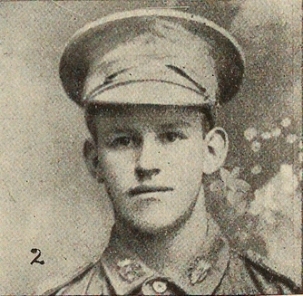
William James Clifford (1897-1917)
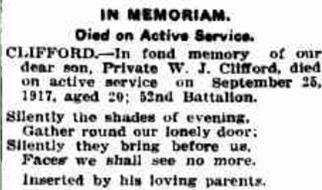
The Mercury 26 Sep 1933
His uncle, Albert Arthur Reader had been killed earlier in the year at the Battle of Lagnicourt. He had served as a stretcher bearer at Gallipoli, having enlisted within a fortnight of the start of the war. He was posthumously awarded a Military Medal for bravery under heavy fire as a stretcher bearer on the 8 Apr 1917.

Albert Arthur Reader (1888-1917)
In a time without the almost instant communication we have now, it sometimes took weeks for all of a family to be informed of a death. In Albert Reader’s service record there is a letter from Louisa Clifford in which she complains that only her brother Charles had been notified of Albert’s death. She says
‘… we are all brothers and sisters, and there are five of us living, so that Charles is no nearer relation than the rest of the family.’
The cry of a woman who had not heard of her brother’s death until it was listed in the Honour Roll of the local newspaper? Louisa placed a death notice for Albert in the Mercury in July 1917. The following year my great grandfather also placed an In Memoriam notice. Albert was buried beside the road in an unmarked grave near Bullecourt. I believe the poetry in some ways tried to make sense of what had happened for those who really only had a glimmer of an idea of what their loved ones had faced.
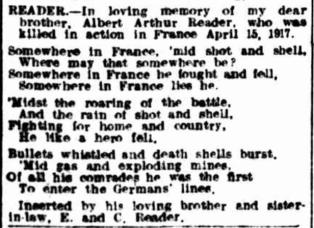
The Mercury 15 Apr 1918
It should be noted though that Albert was not ‘the first/To enter the German lines.’ He was a stretcher bearer and died carrying the wounded.
Twelve years after Albert’s death, his niece, my grandmother named my father Albert after him.
Those who returned came back irrevocably changed, many bearing scars, physical and psychological, which affected the lives of the families who struggled to support them.
My grandfather John Stanislaus ‘Stan’ Merrick was one whose scars were not obvious. He was 18 when he enlisted in 1915. He was sent to the Middle East but returned and was discharged in 1916 as medically unfit, suffering heart strain and debility. He re-enlisted in the 12th Battalion in May 1917. He served in France and was recommended for the Military Medal at Clery in Dec 1918 (not awarded) and was Mentioned in Despatches in Jan 1919. He was forever changed by his years in France, his psychological scars placed their mark upon his children as well.
Stan Merrick aged 18
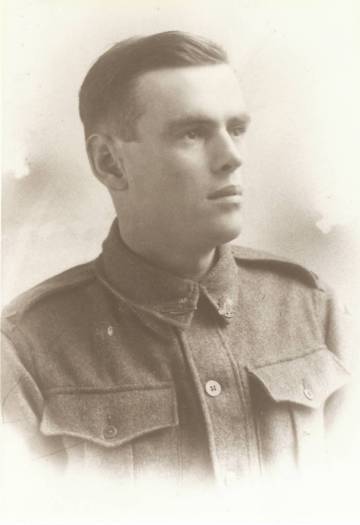
John Stanislaus Merrick (1987-1966)
These are the ordinary men I think of when I attend a commemorative ceremony and most families have similar stories and thoughts. When we see their photographs we think of our own sons of that age, strong, clear eyed,standing tall and we feel a tremor of the sorrow that their own parents felt when they left and, too often, when news came of their deaths.
So we remember them.
***
Perhaps, since I am a librarian, the most obvious element of commemoration has been the constant stream of books – biographies, scholarly examinations of battles and campaigns, novels, poetry collections, even children’s picture books. Like all books these are of varying quality – perhaps the most moving of all for me have been 1914: Poetry Remembers edited by Carol Ann Duffy, Wake by Anna Hope and The Lie by Helen Dunmore. None of these are Australian authors and, offhand I doubt that I have read a single novel by an Australian about the War published since 2014. There are, of course, excellent books written before the period of commemoration – Daughters of Mars by Thomas Keneally(2012) and The Great War by Les Carlyon (2006) to name only two.
As far as public commemorations go, the two most stunning have occurred in Britain. To mark one hundred years since the first full day of Britain’s involvement in the War an art installation Blood Swept Lands and Seas of Red was created created by artists Paul Cummins and Tom Piper at the Tower of London. Between 17 July and 11 November 2014 888,246 ceramic poppies progressively filled the Tower’s moat, each poppy representing a British or colonial fatality during the war. The title was taken from the first line of a poem by an unknown soldier.
A sea of red made up of 888,426 lives lost.
Perhaps more heartbreaking was the commemoration of the first day of the Battle of the Somme on which 19,240 British soldiers died. In London and in cities across Britain, ‘ghost soldiers’ in World War 1 uniforms lounged against walls, stood and sat on footpaths or strolled, silent, through the streets. They handed out cards each of which bore the name of a soldier who had died on that day. A commenter on Twitter said ‘I can’t tell you how powerful it is seeing them leave – probably knowing they aren’t coming back.’
This put faces to the men who, a hundred years before, had walked through those same streets on their way to France.
The War has certainly been commemorated here in Australia but nothing has come near to this in size, poignancy or in ability to capture the public imagination. The bulk of public emotion appears to have been expended mainly on the 100th anniversary of the Gallipoli landing with record number turning out to the Dawn Services across the country. 85,000 people attended the service at the Melbourne Shrine of Remembrance on 25 April 2015.
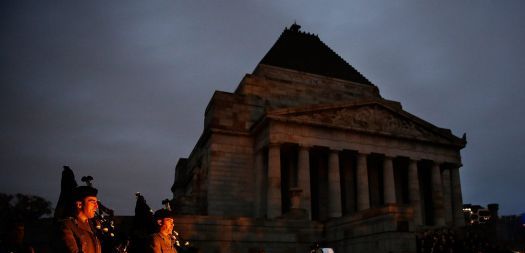 Dawn Service Shrine of Remembrance 25 April 2015
Dawn Service Shrine of Remembrance 25 April 2015
The Australian War Memorial has a series of ongoing projects commemorating Australia’s involvement in World War 1. The centerpiece is an exhibition called The Spirit of Anzac which is travelling around the country and tells the story of Australia’s involvement in the World War 1, and of Australia’s armed forces service in all wars, conflicts and peacekeeping operations over the ensuing century. It includes visuals, artifacts, audio and film and includes local stories drawn from the communities where the exhibition is shown.
Also, from 4 August 2014 until 11 November 2018, the name of each of the 62,000 Australians who gave their lives during the World War 1 is being projected onto the façade of the Hall of Memory at the Australian War Memorial in Canberra. The names are displayed for 30 seconds from sunset to sunrise every night, and are visible from the Memorial’s grounds. The name of each service person will have been display a number of times by November 2018.
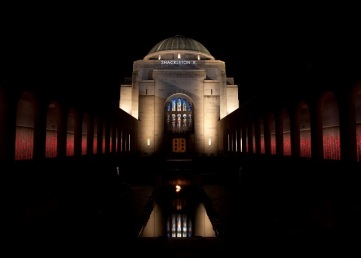 Roll of Honour names
Roll of Honour names
The War Memorial also has a Roll of Honour Soundscape project. Primary school students from across Australia have recorded the names and ages of the Australians who died in service during the War. The recordings are played in the Memorial’s First World War cloisters.
While the national commemorations, although moving for those attending, have not drawn us close in the way the British commemorations have, there are local initiatives that bring us face to face with those who served and died.
Two local efforts stand out for me. Tasmania in the Great War 1914-1918 is a Facebook page, established by a group of Tasmanian local historians, dedicated to Tasmanian servicemen and women who served in the Great War. It aims to bring into one place, as far as possible, a photograph of every service person who either enlisted in Tasmania or was born in Tasmania and enlisted elsewhere. The organizers of the page not only tirelessly search newspapers and archives for photographs but encourage family members to add photographs. To sit and scroll through the images on this page, each with its small biography, is to look into the faces of those who served. Some came home and married, some died prematurely, many did not return. Looking at the page, a war one hundred years ago becomes personal and present.

The Tasmanian Headstone Project is another dedicated group of Tasmanians who in 2012 aimed to provide basic headstones for those servicemen who were buried in unmarked graves. Initially they expected that there would be 30 to 40 unmarked graves at Cornelian Bay cemetery in Hobart. So far more than 250 unmarked graves have been identified and it is believed that there could be as many as 600 veterans in unmarked graves across Tasmania, most of whom do not qualify for a government sponsored war grave. Graves were left unmarked for a variety of reason, some men did not have families but primarily it is believed to be due to financial difficulties. Basic cement headstones for the unmarked graves are being made by volunteers, the material needed paid for through grants from differing levels of government and private donations.
There are many, many more projects both national, state, local and personal. All aim to ensure that those who sacrificed for us are not forgotten.
_______________________________________________________
©Catherine Anne Merrick
Flanders Poppy: via Wikimedia Commons – Author: Tijl Vercaemer from Gent, Flanders #Belgium)
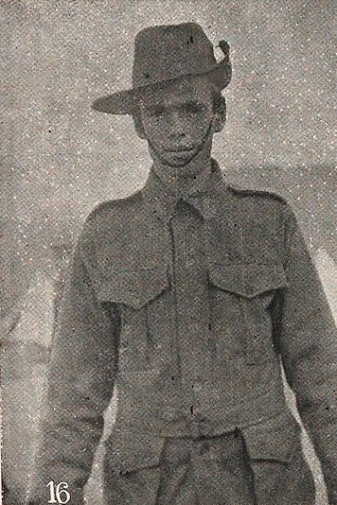
I think I recognised from a very young age how those psychological scars pass down the generations. My great-uncle was killed in 1918 and my grandfather in 1940. My mother was never the same again and that, in turn, affected me in no small measure.
LikeLiked by 1 person
With my father’s family it was the psychological burdens brought back and the effect that had on Dad and his siblings. I really only developed a real sense of it as an adult, particularly once I started looking into our family history.
LikeLiked by 1 person
I thought this a beautiful post, insightful and informative with glorious photos.
LikeLike
Thank you Barbara, I’m glad you liked it. Although it is now 100 years ago, we are still very much touched by World War 1, particularly through the lives of those individual men related to us. I hope they are never forgotten.
LikeLike